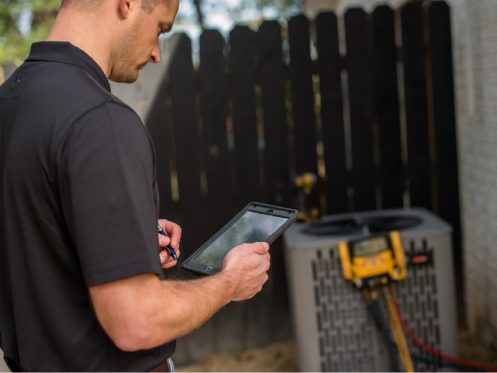As many people struggle with seasonal allergies, many homeowners have opted to invest in “air scrubbers.” The challenge lies in choosing the right air scrubber for your home. That is often easier said than done as there are numerous different makes and models on the market.
What Is an Air Scrubber?
Traditionally, scrubber systems are air pollution control devices that scrub chemicals or gases or both. NASA funded the development of a scrubber system for the International Space Station. It combined mechanical air filtration, absorption filtration, ultraviolet air purification and surface cleaning via negatively charged ions. This technology was later repurposed for homes and small businesses and sold commercially as an air scrubber.
Air Scrubber vs. Air Filter, Purifier or Cleaner
An air filter generally refers to a unit that only has mechanical filtration, such as a high-efficiency particulate air filter. The terms air purifier and air cleaner are often used interchangeably. They generally refer to a unit that has more than one filtration stage, such as HEPA plus activated carbon.
Consumers shouldn’t assume that a product fits these definitions based on marketing. The EPA does not regulate the use of these terms. You can therefore find products on the market that are called air scrubbers but provide no surface disinfecting. Understand which features you want, and identify the specific stages a product offers. If you need assistance, you can always reach out to our team.
Centralized vs. Decentralized HVAC
There are two core types of air scrubbers: standalone units and devices designed to be installed in ductwork. An integrated air scrubber is an affordable and effective option for homes with centralized HVAC. If you don’t have ducts, you’ll need to consider the standalone type. Note that standalone units may be considered for homes with central HVAC as well. Whether it is worthwhile simply depends on the size of your space and how much air you need to move.
Overall Size of the Living Space
Many consumer-grade air purification systems have square footage estimates. If you want a more accurate picture of how much filtration you need, you’ll have to dive a bit deeper. Measure each room by multiplying the length by the width by the height. Add all of the rooms and other areas together to get the overall volume of the living space.
Cubic Feet Per Minute
Just about every air scrubber, purifier, cleaner, and filter on the market will list cubic feet per minute (CFM) on the packaging. This is a measure of how much air a unit can clean in a minute. Multiply by 60 to determine how much air the product can clean in an hour.
Treatment Volume
Most homes will only need one air scrubber with a CFM of 500, which is typical. But if you have a large treatment volume, it may be more practical to purchase multiple small units. You can calculate treatment volume by multiplying the CFM by 60 and then dividing by the air changes per hour. To determine this formula most accurately, it’s always best to discuss your needs and expectations with an HVAC professional.
Your Local IAQ Pros in South Central Texas
GVEC Air Conditioning & Heating is proud to serve South Central Texas and has locations in Cuero, Gonzales, La Vernia, Schertz and Seguin. Our company has served homeowners and businesses throughout these communities and the surrounding areas since 1968. We can meet all of your indoor air quality needs, including the installation of an air scrubber like the popular REME Halo® model.
We can also perform energy audits. In addition, our technicians install, service and repair all manner of heating and cooling equipment. That includes furnaces, heat pumps, air conditioners and ductless systems.
Call GVEC Air Conditioning & Heating today or contact us online to schedule an appointment or to learn more about our services and products!



